| Postage Dues |
| Item # |
|
Never Hinged US$ |
Mint Hinged US$ |
Used US$ |
||
| 248065 |
J1 Printing 2, AFA #P1.2, AFA Plate II (second printing) [1902 1 cent Postage Due] NEVER HINGED XF-Superb lower left corner margin 4-block. Printing / Plate confirmed by both color and cliche types (left side type 1, right side type 2) per DuBois (unpublished 1997). [In early philatelic literature, both AFA Plates I and II were described as "Plate I", with a small dot above the I of DIEN.] The perforations are all present and excellent, but many holes are debris-filled as typical for this printing (thus I did not clean out the holes); this is an important point of identification. Blocks of this printing / plate are quite unusual, especially corner margin blocks. I believe that this is the first block of this printing / plate that I have been able to offer in 50 years! This block shows further "flyspeck" varieties for these positions (and possibly these types with further confirmation of consistency across all positions of the types) which could be added to the listing by DuBois. A beautiful example of a scarce multiple and also a philatelically important item. Upon request at time of purchase, the purchaser may receive a draft copy of the 1997 unpublished research paper by DuBois. This is free, but may not be reproduced or distributed in any form whatsoever without my permission. I am the copyright holder.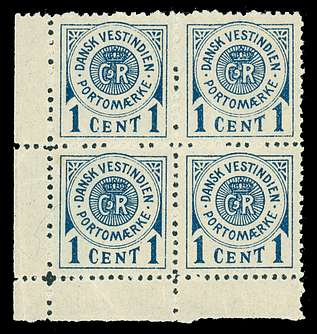 ACTUAL item. |
Reference |
--- | --- | ||
| 248067 |
J1 Printing 3, AFA #P1.3, AFA Plate IIIa (third printing) [1902 1 cent Postage Due] NEVER HINGED XF/VF/F-VF vertical upper right corner margin 10-block. Printing / Plate confirmed by color and paper. This printing exists with a light to dark range of color shades; this example is at the light end of that spectrum. Cliche types (left side type 4, right side type 5) per DuBois (unpublished 1997). [In early philatelic literature, both AFA Plates III/IIIa and III/IV were described as "Plate II", without a small dot above the I of DIEN.] Very fresh and bright appearance, with perfect perforations, however, four stamps show small age spots on the reverse. Blocks of this printing / plate are quite unusual, especially marginal blocks. Of the Cents postage dues, this printing / plate is one for which no sheet is in the postal museum and a sheet is otherwise not recorded to exist. (Thus blocks are important to determine the location of cliche varieties.) I believe that this and three other blocks of this printing / plate are the first that I have been able to offer in 50 years! This block shows further "flyspeck" varieties for these positions (and possibly these types with further confirmation of consistency across all positions of the types) which could be added to the listing by DuBois. Specifically, in addition to all ten stamps showing small undescribed type differences, the plate positions 19 and 20 stamps (second row of this block) shows a prominent "spray" of color dots around the CENTS. A beautiful example of a scarce multiple and also a philatelically important item. Upon request at time of purchase, the purchaser may receive a draft copy of the 1997 unpublished research paper by DuBois. This is free, but may not be reproduced or distributed in any form whatsoever without my permission. I am the copyright holder.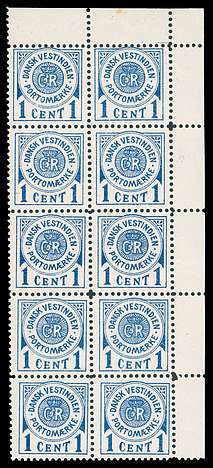 ACTUAL item. |
175.00 |
--- | --- | ||
| 248068 |
J1 Printing 3, AFA #P1.3, AFA Plate IIIa (third printing) [1902 1 cent Postage Due] NEVER HINGED XF/VF/F-VF vertical upper right corner margin 10-block. Printing / Plate confirmed by color and paper. This printing exists with a light to dark range of color shades; this example is at the dark end of that spectrum with smooth ink coverage. Cliche types (left side type 4, right side type 5) per DuBois (unpublished 1997). [In early philatelic literature, both AFA Plates III/IIIa and III/IV were described as "Plate II", without a small dot above the I of DIEN.] Very fresh and bright appearance, with perfect perforations, some separation and bends in the selvage. Blocks of this printing / plate are quite unusual, especially marginal blocks. Of the Cents postage dues, this printing / plate is one for which no sheet is in the postal museum and a sheet is otherwise not recorded to exist. (Thus blocks are important to determine the location of cliche varieties.) I believe that this and three other blocks of this printing / plate are the first that I have been able to offer in 50 years! This block shows further "flyspeck" varieties for these positions (and possibly these types with further confirmation of consistency across all positions of the types) which could be added to the listing by DuBois. A beautiful example of a scarce multiple and also a philatelically important item. Upon request at time of purchase, the purchaser may receive a draft copy of the 1997 unpublished research paper by DuBois. This is free, but may not be reproduced or distributed in any form whatsoever without my permission. I am the copyright holder.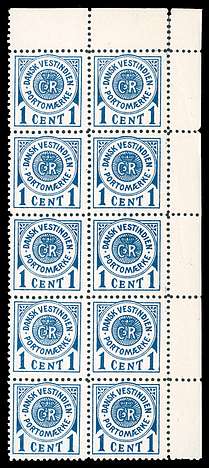 ACTUAL item. |
Reference |
--- | --- | ||
| 248069 |
J1 Printing 3, AFA #P1.3, AFA Plate IIIa (third printing) [1902 1 cent Postage Due] NEVER HINGED F-VF/Fine horizontal bottom margin 14-block. Printing / Plate confirmed by color and paper. This printing exists with a light to dark range of color shades; this example is at the light end of that spectrum. Cliche types (from left to right: 4,5,1,2,3,4,5) per DuBois (unpublished 1997). [In early philatelic literature, both AFA Plates III/IIIa and III/IV were described as "Plate II", without a small dot above the I of DIEN.] Very fresh and bright appearance, though some minor separations and lower right stamp with a spot. Blocks of this printing / plate are quite unusual, especially marginal blocks. Of the Cents postage dues, this printing / plate is one for which no sheet is in the postal museum and a sheet is otherwise not recorded to exist. (Thus blocks are important to determine the location of cliche varieties.) I believe that this and three other blocks of this printing / plate are the first that I have been able to offer in 50 years! This block shows further "flyspeck" varieties for these positions (and possibly these types with further confirmation of consistency across all positions of the types) which could be added to the listing by DuBois. Because the denominations were individually added to a 5-strip on an intermediate lithographic stone that was then reproduced to make the full plate/stone -- as demonstrated by the 4 Cent denomination with five vastly different figures of "4" -- 5-strip examples, showing types 1-5, of all the denominations, are very much sought after. A beautiful example of a scarce multiple and also a philatelically important item. Upon request at time of purchase, the purchaser may receive a draft copy of the 1997 unpublished research paper by DuBois. This is free, but may not be reproduced or distributed in any form whatsoever without my permission. I am the copyright holder.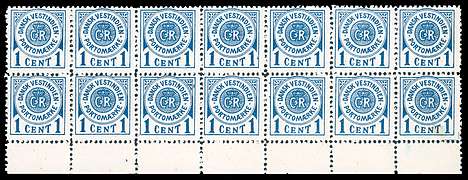 ACTUAL item. |
Reference |
--- | --- | ||
| 248070 |
J1 Printing 3, AFA #P1.3, AFA Plate IIIa (third printing) [1902 1 cent Postage Due] NEVER HINGED F-VF/Fine horizontal right margin 12-block. Printing / Plate confirmed by color and paper. This printing exists with a light to dark range of color shades; this example is at the dark end of that spectrum. Cliche types (from left to right: 5,1,2,3,4,5) per DuBois (unpublished 1997). [In early philatelic literature, both AFA Plates III/IIIa and III/IV were described as "Plate II", without a small dot above the I of DIEN.] Very fresh and bright appearance. Blocks of this printing / plate are quite unusual, especially marginal blocks. Of the Cents postage dues, this printing / plate is one for which no sheet is in the postal museum and a sheet is otherwise not recorded to exist. (Thus blocks are important to determine the location of cliche varieties.) I believe that this and three other blocks of this printing / plate are the first that I have been able to offer in 50 years! This block shows further "flyspeck" varieties for these positions (and possibly these types with further confirmation of consistency across all positions of the types) which could be added to the listing by DuBois. Because the denominations were individually added to a 5-strip on an intermediate lithographic stone that was then reproduced to make the full plate/stone -- as demonstrated by the 4 Cent denomination with five vastly different figures of "4" -- 5-strip examples, showing types 1-5, of all the denominations, are very much sought after. A beautiful example of a scarce multiple and also a philatelically important item. Upon request at time of purchase, the purchaser may receive a draft copy of the 1997 unpublished research paper by DuBois. This is free, but may not be reproduced or distributed in any form whatsoever without my permission. I am the copyright holder.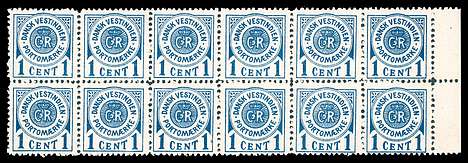 ACTUAL item. |
Reference |
--- | --- | ||
| 248066 |
J1 Printing 4, AFA #P1.4, AFA Plate IIIb (fourth printing) [1902 1 cent Postage Due] NEVER HINGED VF/F-VF vertical 6-block. Printing / Plate confirmed by color and paper. Cliche types (left side type 3, right side type 4) per DuBois (unpublished 1997). [In early philatelic literature, both AFA Plates III/IIIa and III/IV were described as "Plate II", without a small dot above the I of DIEN.] Wonderfully fresh and bright with perfect perforations. Blocks of this printing / plate are quite unusual. Of the Cents postage dues, this printing / plate is one for which no sheet is in the postal museum and a sheet is otherwise not recorded to exist. (Thus blocks are important to determine the location of cliche varieties.) I believe that this is the first block of this printing / plate that I have been able to offer in 50 years! This block shows further "flyspeck" varieties for these positions (and possibly these types with further confirmation of consistency across all positions of the types) which could be added to the listing by DuBois. Specifically, in addition to all six stamps showing small undescribed type differences, the lower right stamp shows a prominent vertical plate scratch from the inner circle above the N of DANSK, down through the outer circle below the OR of PORTO. A beautiful example of a scarce multiple and also a philatelically important item. Upon request at time of purchase, the purchaser may receive a draft copy of the 1997 unpublished research paper by DuBois. This is free, but may not be reproduced or distributed in any form whatsoever without my permission. I am the copyright holder.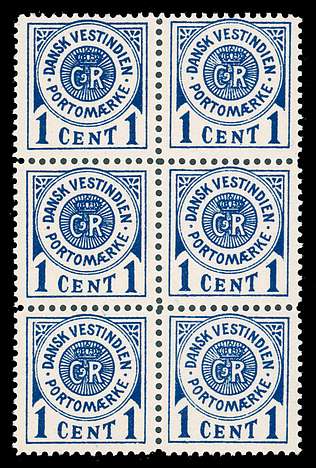 ACTUAL item. |
Reference |
--- | --- | ||
| 246498 |
J8 Print 1, AFA #Porto 8.1 Dark Grayish Brown Center [1905 50 bit Postage Due] Used with VF centering and with very small, light magenta cancellation -- possibly a strike of the Customs House cancellation, but not enough present to know. A pretty example.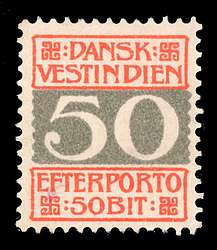 ACTUAL item. |
--- | --- |
46.00 |
||
| 246468 |
J8a [1915 50 bit Postage Due, Perforation 14 x 14.25] February 1916 printing with small perforation holes. Mint, lightly hinged, with F-VF+ centering. This is a seldom-offered stamp in any condition or centering, however, this is unusually nice centering for this scarce stamp. This one is missing from most collections. [ Additional background information: Though for all to see there are details on this stamp in "DWI Mails" Volume 2, and a listing in the 2016 AFA Specialized Catalog, "virtually nobody" seems to be aware that the stamp with this perforation had two printings: March 1915 VS February 1916. The information in "DWI Mails" dates from 1981 but is fairly extensive, while the 2016 AFA Specialized may (?) be more up-to-date, but lacks detail and context. AFA mentions the perforation hole size are large vs small, while "DWI Mails" states that the March 1915 printing "has slightly larger holes than [the next] printing because the perforating was done by a new machine put in use in 1913. Only "DWI Mails" mentions the shipwreck damaging the March 1915 stamps. Both mention the colors under daylight, but with somewhat different color naming ("DWI Mails" color names given below). Only "DWI Mails" mentions the gum characteristics or the colors under UV light. The sum of the information appears to be: March 1915 Printing 3 (of all 50 bit stamps); light yellowish-gray (under UV: light violet-gray) and deep orange-red. Crackly white gum with larger perforation holes. 5,000 printed, but the ship "ran aground badly water-damaging the stamps". Of those 50 (mostly?) damaged sheets of stamps, 20 sheets are in the Danish postal archives "wrinkled and without gum from the mentioned water damage". That leaves no more than 3,000 of the March 1915 printing, but "It is not known how many ... were used at DWI or discarded ... but they must be considered rare, especially if they still have their original crackly white gum." February 1916 Printing 4 (of all 50 bit stamps); medium gray and medium orange-red (under UV: dark gray-violet center and strong red-lilac frame). Smooth yellowish gum with smaller perforation holes. (In my experience, the perforation hole size may NOT always be the best identifier.) 15,000 printed. "DWI Mails" states that in 1957 3,000 50 bit stamps were destroyed by burning [by the Danish authorities], but apparently it is not known from which printing(s) those stamps came. Because the third and fourth printings appear to have been made out of necessity because apparently the earlier printings had been consumed, it would be a reasonable assumption that excess stamps remained only from the fourth (February 1916) printing, thus lowering that issue quantity to a net of 12,000. I have never seen a collection that contained both printings, or that even mentioned that there were two printings! The March 1915 printing is "rarely" offered (and should be expertized). I have only recorded having a single example and it is certainly tremendously scarcer than the one-quarter of the issue quantity which AFA states -- I suspect that no more than a couple or few hundred examples survived. The information in Facit is very limited: Facit does not list any of the printings on the 1905-1916 postage dues, they give an issue date for this stamp as 1913, and they state a total quantity of 15,400. I have suggested to Facit that they take a closer look at this whole 1905-1916 postage due issue.]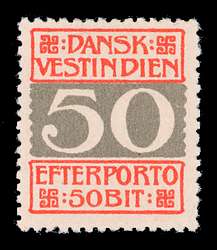 ACTUAL item. |
--- |
Reference |
--- |